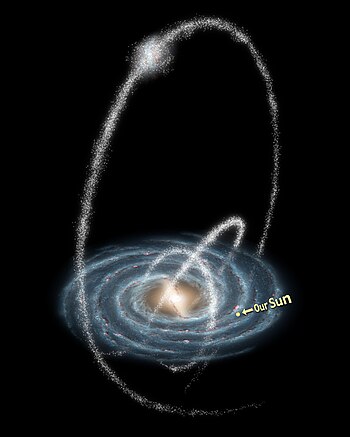Virgo overdensity
| Virgo Overdensity / Virgo Stellar Stream | |
|---|---|
| Streams of Stars (artist's impression) | |
|
Observation dates equinox : J2000.0 , epoch : J2000.0 |
|
| Constellation | Virgo |
| Right ascension | 12 h 24 m |
| declination | −1 ° 09 ′ 0 ″ |
| Angular expansion | > 2000 deg 2 |
| Surface brightness | 32.5 mag / arcmin 2 |
| Physical data | |
| Affiliation | Milky Way , Local Group |
| Radial velocity | approx. 130 km / s |
| distance | approx 20k pc |
| Metallicity | [Fe / H] ≈ −2 |
| history | |
| discovery |
Virgo Overdensity:
Virgo Stellar Stream:
|
The Virgo Overdensity ( VOD , English for Virgo overfrequency ) is a region of the sky with increased star density in the constellation Virgo . The nature of the phenomenon has not yet been clarified and is the subject of current research. Many observations suggest that it is the remains of a spheroid dwarf galaxy that is just merging with the Milky Way . A suitable structure is known as Virgo Stellar Stream ( VSS , English for Virgo-Strom / Virgo-Sternstrom ). The relationship between the objects called Virgo Overdensity and Virgo Stellar Stream has yet to be clarified, but there are indications that these are related structures with a common origin. An alternative explanation for the Virgo Overdensity would be that it is a large-scale structure of the stars of the galactic halo.
discovery
The current was after analysis of photometric data of the screening of the SDSS discovered (short SDSS) having a three-dimensional map of the Milky Way means of -magnitude relationship colors and certain standard candles to estimate their distance created ( Photometric parallax ).
The first proposal for a new galaxy in the constellation Virgo was made in 2001 based on data from the Quasar Equatorial Survey Team . Within this project, the 1.0 was built using meters - Schmidt Telescope at the Llano del Hato National Astronomical Observatory in Venezuela for RR Lyrae searched Stars. Five of these variable stars were found in a cluster at the coordinates near the right ascension 12 h 24 m . The astronomers of the project then assumed that this cluster is a small dwarf galaxy that is cannibalized by the Milky Way (“12.4 hour clump”).
properties
The Virgo Overdensity is at least 2000 square degrees ; its actual extent is probably about 3000 square degrees of the celestial sphere (about 15% of the night sky ). Despite the considerable angular extent, it contains only a few hundred thousand stars. The low surface brightness (only around 32.5 mag / arcmin 2 ) significantly impaired the discovery in surveys before the SDSS. The number of stars hardly exceeds that of a typical globular cluster, and the Virgo dwarf was described by a member of the discovery team as a "rather sickly galaxy" compared to our Milky Way.
Many of its stars have been known for centuries and were mistaken for members of the Milky Way itself, although at least their low metallicity made them appear strange to the other stars of the Milky Way.
The Virgo Over density is within the Milky Way, about 10 k pc (or 30,000 light-years ) from the sun away and extends over a region of the space with at least 10 kpc diameter. It lies near the level with the Sagittarius dwarf galaxy , which was identified in 1994 by a similar photometric survey. The Sagittarius dwarf is a small dwarf galaxy that merges with the Milky Way. It is, however, about 4 times further away. This makes it unlikely that these two are physically directly linked, although it does appear possible that the Virgo Current is a tidal holdover on the orbit of the dissolving Sagittarius dwarf galaxy in its orbit around the Milky Way.
The cloud-like morphology of the Virgo Overdensity differs significantly from that of stellar currents such as the Monoceros Ring , which was discovered in 2002 and is considered the tidal remnant of the Canis Major dwarf galaxy , which merges with the Milky Way.
additional
Web links
- Scientists find a galaxy joining ours ( International Herald Tribune , Jan 10, 2006)
- New Milky Way neighbor ( Astronomy , Jan 12, 2006)
Individual evidence
- ↑ a b c Sonia Duffau, et al., 2006, Spectroscopy of QUEST RR Lyrae Variables: the new Virgo Stellar Stream , The Astrophysical Journal , Volume 636, Issue 2, pp. L97-L100 ( bibcode : 2005NewAR..49..465R ; arxiv : astro-ph / 0510589 )
- ↑ Mario Jurić, et al., October 2005, The Milky Way Tomography with SDSS , The Astrophysical Journal ( arxiv : astro-ph / 0510520 )
- ^ The Sloan Digital Sky Survey Reveals A New Milky Way Neighbor , SDSS press release, January 9, 2006
- ↑ Katherina Vivas et al., 2001, The QUEST RR Lyrae Survey: Confirmation of the Clump at 50 Kiloparsecs and Other Overdensities in the Outer Halo , The Astrophysical Journal, Volume 554, Issue 1, pp. L33-L36.
- ^ "Pathetic galaxy" , Space Daily , January 10, 2006
- ↑ Ibata, RA, et al., 1994, A Dwarf Satellite Galaxy in Sagittarius , Nature , Volume 370, Number 6486, p. 194.
- ↑ The origin of the Virgo tidal stream ( Memento of February 8, 2012 in the Internet Archive ), David Martínez-Delgado, Workshop on Dwarf Galaxies as Astrophysical and Cosmological Probes, March 17, 2006. (PDF)
- ↑ Newberg, HJ, et al., 2002, The Ghost of Sagittarius and Lumps in the Halo of the Milky Way , The Astrophysical Journal, Volume 569, Issue 1, pp. 245-274
